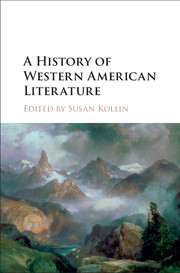Book contents
- Frontmatter
- Contents
- Notes on Contributors
- Acknowledgments
- Introduction: Historicizing the American Literary West
- PART I HOMELANDS
- PART II MAKING A REGION
- 3 Domestic Frontiers: Settler Narratives by European American Women Writers
- 4 Labor and the Land: Narratives of Trading, Mining, and Ranching
- 5 Nature Writing and the American West
- 6 Tall Tales and Short Stories
- 7 The Popular Western
- PART III GEOGRAPHIES OF THE LITERARY WEST
- PART IV THE TWENTIETH CENTURY AND BEYOND: LITERARY MOVEMENTS AND CRITICAL PERSPECTIVES
- Selected Bibliography
- Index
6 - Tall Tales and Short Stories
from PART II - MAKING A REGION
Published online by Cambridge University Press: 05 November 2015
- Frontmatter
- Contents
- Notes on Contributors
- Acknowledgments
- Introduction: Historicizing the American Literary West
- PART I HOMELANDS
- PART II MAKING A REGION
- 3 Domestic Frontiers: Settler Narratives by European American Women Writers
- 4 Labor and the Land: Narratives of Trading, Mining, and Ranching
- 5 Nature Writing and the American West
- 6 Tall Tales and Short Stories
- 7 The Popular Western
- PART III GEOGRAPHIES OF THE LITERARY WEST
- PART IV THE TWENTIETH CENTURY AND BEYOND: LITERARY MOVEMENTS AND CRITICAL PERSPECTIVES
- Selected Bibliography
- Index
Summary
Legend has it that during the height of the great silver mining rush, an unusually creative newspaper editor essentially invented a town out of nothing. For several years he maintained the joke by reportedly publishing a weekly paper that chronicled his town's entirely fictional economic, political, and social activities. Judging by the editorials, news items, and even advertising that the editor created, one would have thought that to the south of Carson City, Nevada, just across the California state line on the silver-rich eastern flanks of the Sierra Nevada mountains, lay a town of at least one thousand residents with enough grocery and clothing stores, not to mention saloons and banks and theaters, to meet the needs of an even greater population. Regional folklore also maintains that this endlessly inventive editor carried off the hoax at the behest of secretive speculators who wished to sell nonexistent shares in a nonexistent mine to investors in Britain. Finally, the legend states that the newspaperman known as “Lying Jim” Townsend not only served as the model for the speaker in Bret Harte's “Plain Language from Truthful James,” but also was the original teller of a tale about a jumping frog that eventually found its way into Mark Twain's hands.
The known facts of James W. E. Townsend and his literary work are more mundane, though. For one, while his mendacity may actually have proven an inspiration to Harte, he was almost certainly not the originator of the jumping frog story. And the story of the town is also more legend than fact. In 1888, Townsend returned to the largely deserted town of Lundy, California, to resume the editorship of its moribund Homer Mining Index. Many of the advertising and mining patents he printed were simply borrowed from an earlier decade when both the town and the paper had been more prosperous. The core of the legend does, nevertheless, have some truth to it, for Townsend really did publish a fair number of entirely fictitious reports about what had transpired, such as a story about a somnambulist who returned every morning with his pockets mysteriously filled with gold ore (“Billy” had apparently discovered in his sleep a mine that had eluded everyone's notice in daylight). Of course, Townsend's assessments of mostly nonexistent mines did have an impact on stock value in the vicinity.
- Type
- Chapter
- Information
- A History of Western American Literature , pp. 98 - 110Publisher: Cambridge University PressPrint publication year: 2015

